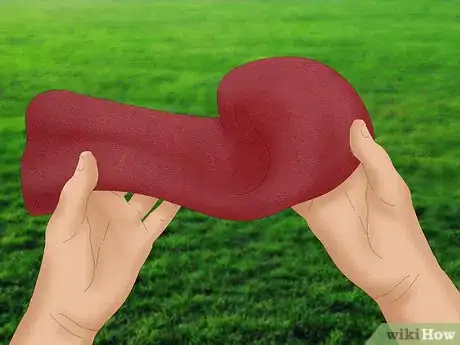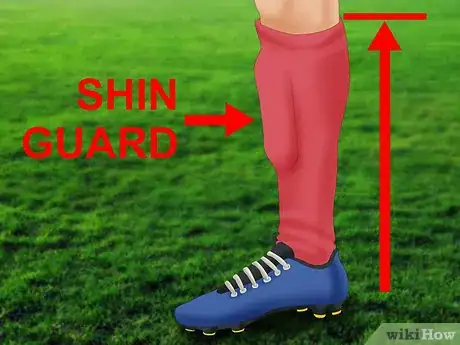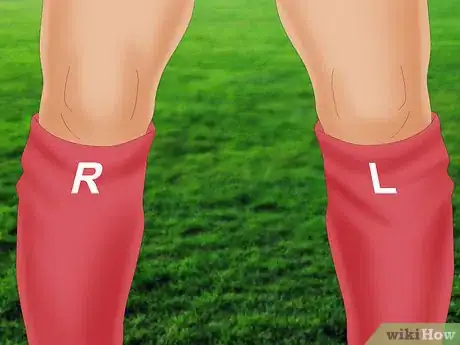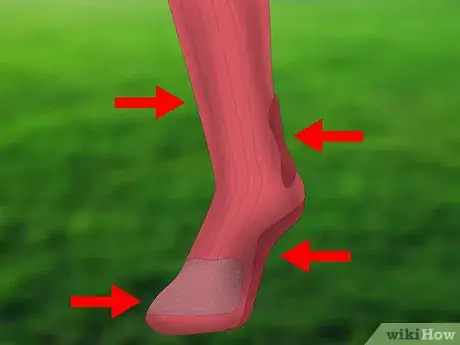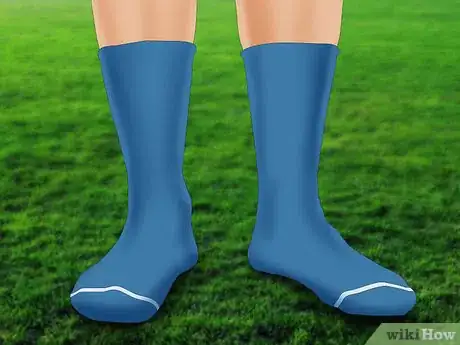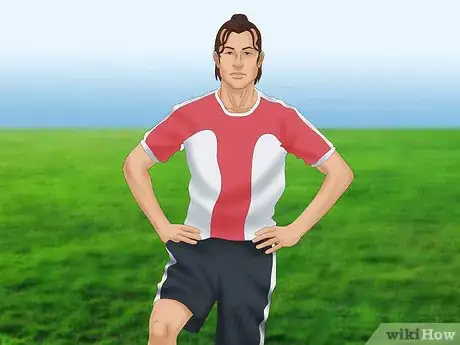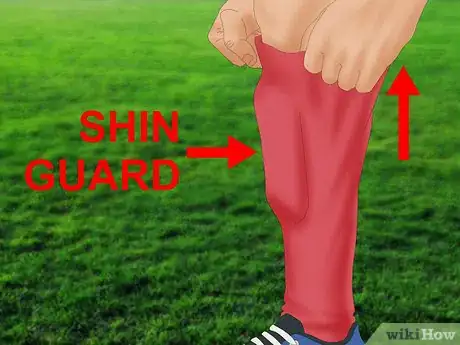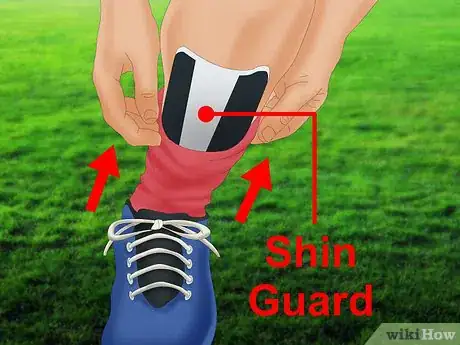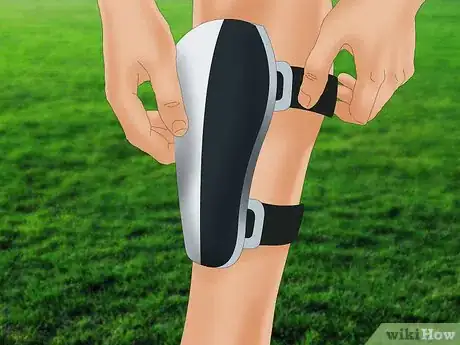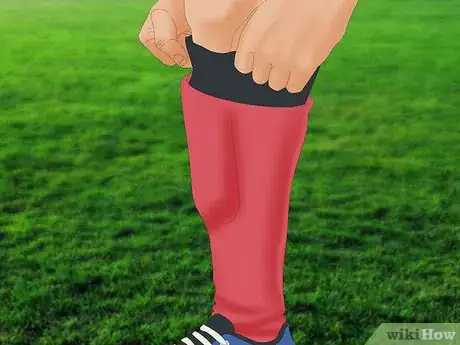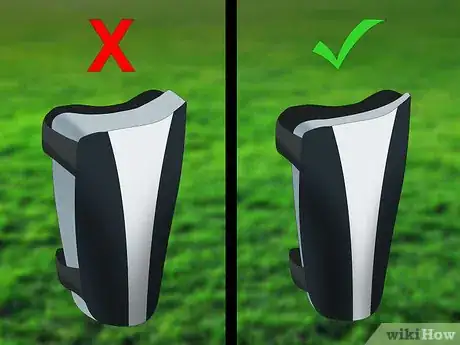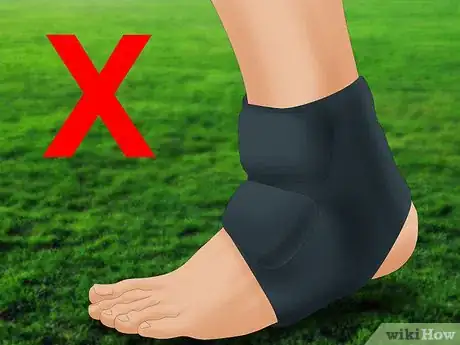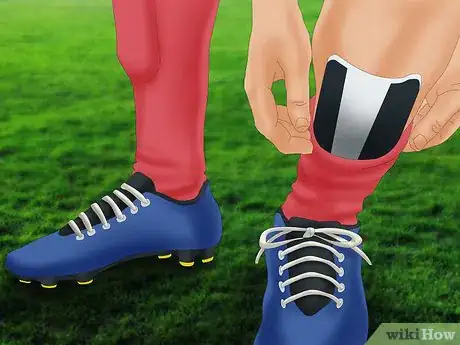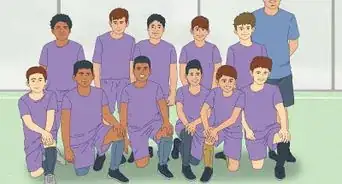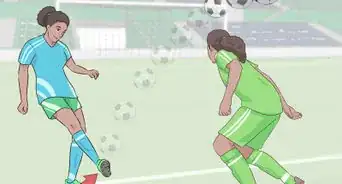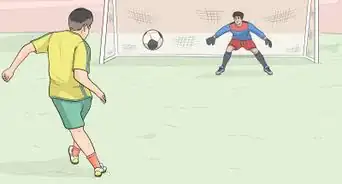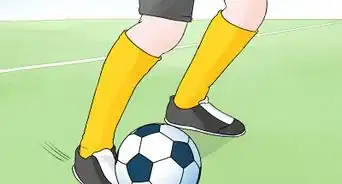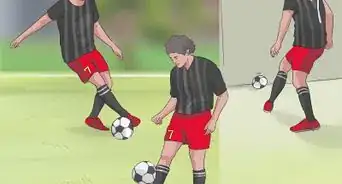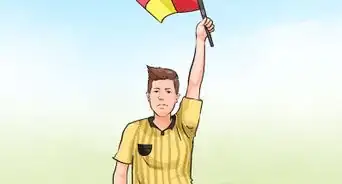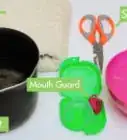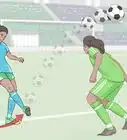This article was co-authored by wikiHow Staff. Our trained team of editors and researchers validate articles for accuracy and comprehensiveness. wikiHow's Content Management Team carefully monitors the work from our editorial staff to ensure that each article is backed by trusted research and meets our high quality standards.
This article has been viewed 72,142 times.
Learn more...
There are many different brands of soccer socks. Each brand has its own type of performance and protective technology. Depending on your level, you coach or team may require specific colours or a single brand to be worn. You may also choose a specific type of sock that meets your personal needs. Research and create a budget for the type of sock that’s best for you. As you choose your socks, focus on construction, material, technology, cost, and the correct shin guard.[1]
Steps
Looking For Key Components
-
1Assess if there is sweat or moisture control. Soccer is a very physical game that is often played outdoors. Between the rain and your sweat, your socks may get extremely moist. Many brands have technology to wick away sweat and moisture. Hygiene, odour issues, and performance can all be affected by extreme moisture. Each brand has its own patented technology:[2]
- Puma technology is referred to as DryCell, CoolPlus Yarn, and CoolCell.
- Nike technology is referred to as Dri-Fit.
- Adidas technology is referred to as ClimaCool and ClimaLite.
- Under Armour technology is referred to as ArmourDry and HeatGear
-
2Find the length that’s comfortable. Each player is comfortable with a different sock length. In an official match, you may need to keep your socks at least above your shin guard. In practice you may find that a shorter length allows for more movement. Cold weather may also affect your decision. Here are some helpful descriptions that you may come across:[3]
- OTC stand for socks that come over the calf. These socks are the longest you can get and usually are worn above your knee.
- Crew refers to socks that cover slightly above your calf.
- Low-cut refers to socks that are below your calf and slightly above your ankle.
- No-show refers to socks that are below your ankle and basically cannot be seen with your shoes on.
Advertisement -
3Invest in socks designed individually for your left and right foot. Invest in higher end technology that creates strategic support, cushioning, and comfort for each foot. These socks will usually have an L or R to indicate which foot to place the sock on to.[4]
-
4Personalize your choice. Choose from a variety of technological specifications including: ribbed ankle support, anti-odor technology, mesh ventilation, achilles cushioning, and arch support. For example, you may need achilles cushioning if you have been injured or find that your shoes irritate that area when you perform certain movements.[5]
-
5Abide by your team’s standards. Team administrators and coaches may have the added responsibility of choosing team colours. They should also consider construction and sweat control as these socks will need to be durable and prevent player issues with hygiene and performance. Think about the ratio of synthetic material against natural material before making your final decision.[6]
- Synthetic materials provide more stretch and can help to manage sweat and moisture. Synthetic materials include polyester and spandex. Natural materials can provide warmth and increased cushioning. These materials include cotton and hemp. A blend of both synthetic and natural materials tend to work best. Also factor in your team’s budget before making the final purchase.[7]
-
6Select training socks that are comfortable. If you don’t wear shin guards while practicing, you have a lot more sock options. Crew socks are very popular for training. No-show and low-cut socks are popular for cardio or gym training.[8]
- You must choose the right size and correct material to meet your comfort and fit needs. Training can be grueling and the wrong fit can lead to painful blisters. Your skin may also get easily irritated by certain material.
-
7Create a budget for the right amount of socks. If you are on a team, you will need two pairs for both your home and away soccer kits. If you play in tournaments, you will most likely play in several games in one day or over a weekend. Training may require at least five pairs depending on how often you intend to train during the week. High-level players may train every day or even two or three times in a single day.[9]
- You can get blisters, athlete’s foot, or severe foot damage if you continuously wear your used socks without cleaning them. Keep in mind that you will also need extra socks for cold weather, if you damage a pair, or if a fresh pair helps with your performance. You may also lose a single sock in the laundry or use specific pairs for specific activities. For example, you may use a special pair for shoot outs.
-
8Find your position. Players at every position prefer different socks lengths. If you are a forward and attack aggressively, you may want your socks to be lower or to have added achilles support for your quick movements and ball handling. Goalies may prefer socks that are thicker and longer when playing in colder weather.
Wearing Your Socks
-
1Prepare for match play. Match play usually requires you to have socks that completely cover your shin guards. You can pull your socks above your knees or fold them under. It is personal preference as long as you abide by the rules of your league.[10]
- Pulling your socks above your knees may be advantageous in cold weather but may prove cumbersome for some players.
-
2Let your shin guards dictate how you wear your socks. Some shin guards have built-in ankle protection and require you to attach them to your leg first before you put your socks on over them. If your shin guards don’t have built-in ankle protection, put your socks and cleats on first. As you put your socks over your shin guards, adjust your guards.[11]
- Younger players usually prefer shin guards with built-in ankle protection.
-
3Set your guard in place. Set your shin guard so that it won’t inhibit your performance. You can lock it into place by wrapping tape at both the top and bottom. There are also guard sleeves that are worn under your sock and hug your guard against your leg.[12]
- Different brands may have guard sleeves together with your shin guards upon purchase while others are sold separately.
-
4Reduce blisters. Players may wear two pairs of socks as the double layer may help to prevent blisters. Simply take a second pair of socks and wear it over your shin guard and first pair of socks. The second pair of socks must be the right size to both accommodate the first layer and not be too large that it slides.[13]
- Socks that fit too small may cut off circulation to your feet; in contrast, socks that are too large may cause your feet to slide within your shoe, which creates blisters.
-
5Personalize the socks you use for match play. Many players take their team issued socks and cut off the foot. Take the remaining top portion of sock and wear it over your prefered type of sock. This way you are able to still represent your team colours while benefiting from the technology of non-team issued socks in your cleat.[14]
- Ask your league if there are any colour requirements for your socks as some may want both the foot portion and the calf portion to be the same colour for official matches.
Choosing the Right Shin Guard
-
1Choose the right material. Your shin guards should be both durable and lightweight. They are normally made from a combination of shock-resistant polypropylene, foam and plastic. Ensure that they won’t negatively impact your performance and are able to withstand a hard tackle.[15]
-
2Make sure your shin guards are light. Bulky shin guards may negatively affect your performance making it difficult to handle the ball or move. If they feel like ankle weights, they may be too heavy. You also want to make sure that they aren’t flimsy and solid enough to protect you from a tackle.[16]
-
3Avoid lower ankle pads or detachable ankle socks. While beginners may opt for them, detachable ankle socks or lower ankle pads may feel uncomfortable or restrictive for more seasoned players. These pads may also soak up a lot of moisture. Many players prefer shin guards with a velcro strap at both the bottom and top to set it in place.[17]
-
4Keep your shin guard in place. Prevent your shin guard from sliding down your leg or getting loose by wrapping tape around the bottom. Avoid letting your your shin guard push against the top of your foot and ankle. Many shin guards only have velcro for the top so that you can tape the bottom to your preference.[18]
- Refresh your tape during half time when you’re playing a match to make sure that it stays in place. If you have a team trainer, ask to tape your feet and ankles to help prevent injury.
-
5Wear shin guards as often as possible. Get use to playing with shin guards so that you feel comfortable with them on during an official match. While you may train without them, increase your performance by doing any soccer related movements with them on.[19]
Community Q&A
-
QuestionHow do I wear socks like Paulo Dybala?
 Community AnswerYou put the upper elastic of your socks folded inside untill you can keep them behind your shin guard.
Community AnswerYou put the upper elastic of your socks folded inside untill you can keep them behind your shin guard. -
QuestionNo matter what brand socks I buy, after a few washes they lose their stretch. I never put them in the dryer and wash in warm water. Is there a trick to get their stretch back?
 Community AnswerTry washing in cold water.
Community AnswerTry washing in cold water. -
QuestionHow do I put my trackers in my football socks?
 AmeirTFR- AmeirTheFriendlyRangerCommunity AnswerFold them of course.
AmeirTFR- AmeirTheFriendlyRangerCommunity AnswerFold them of course.
Warnings
- While highly skilled players may know the proper way to tackle, the heat of the moment may cause overly aggressive plays that can cause injury. Don’t rely on sportsmanship or skill. Shin guards can prevent injuries from mistimed or dubious plays.[20]⧼thumbs_response⧽
- Tackles happen at any angle and at any time. You can injure your calf, ankle, foot, or any other part of your lower body even with shin guards on. You may even get severely bruised or break a bone depending on the size and speed of of the players. Take every precaution necessary to keep yourself safe.[21]⧼thumbs_response⧽
References
- ↑ https://www.soccer.com/guide/guide-to-soccer-socks/
- ↑ https://www.soccer.com/guide/guide-to-soccer-socks/
- ↑ https://www.soccer.com/guide/guide-to-soccer-socks/
- ↑ https://www.soccer.com/guide/guide-to-soccer-socks/
- ↑ https://www.soccer.com/guide/guide-to-soccer-socks/
- ↑ https://www.soccer.com/guide/guide-to-soccer-socks/
- ↑ https://www.soccer.com/guide/guide-to-soccer-socks/
- ↑ https://www.soccer.com/guide/guide-to-soccer-socks/
- ↑ https://www.soccer.com/guide/guide-to-soccer-socks/
- ↑ https://www.soccer.com/guide/guide-to-soccer-socks/
- ↑ https://www.soccer.com/guide/guide-to-soccer-socks/
- ↑ https://www.soccer.com/guide/guide-to-soccer-socks/
- ↑ https://www.soccer.com/guide/guide-to-soccer-socks/
- ↑ https://www.soccer.com/guide/guide-to-soccer-socks/
- ↑ http://www.soccer-training-info.com/shin_guards.asp
- ↑ http://www.soccer-training-info.com/shin_guards.asp
- ↑ http://www.soccer-training-info.com/shin_guards.asp
- ↑ http://www.soccer-training-info.com/shin_guards.asp
- ↑ http://www.soccer-training-info.com/shin_guards.asp
- ↑ http://www.soccer-training-info.com/shin_guards.asp
- ↑ http://www.soccer-training-info.com/shin_guards.asp
